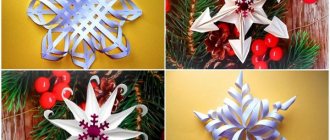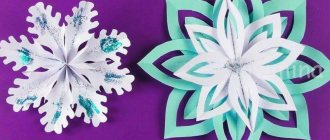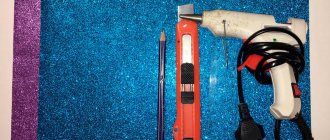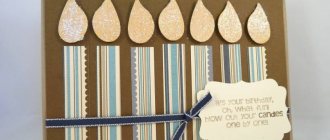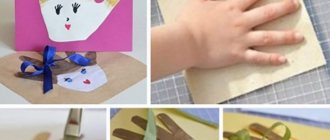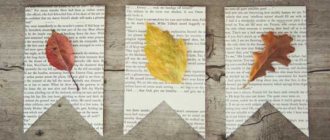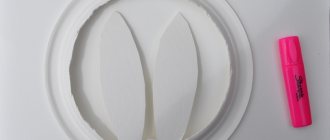What a wonderful person he was who invented the pocket. This is such a convenient device that it’s hard to imagine your daily routine without it. It is very convenient to store coins, keys, phone and other small things in your pocket. It will be great if everyone at home has comfortable and compact pockets, then all small items will be in one place and when needed, finding them will not be difficult. Let's look at how to make paper pockets with your own hands and what you might need for this.
How to make paper pockets for small items
We usually put a variety of small things in our pockets: coins, keys, notes and other items. Using this simple invention of mankind is commonplace, because it is very convenient. But sometimes there are not enough pockets, and then a real hell begins with things scattered everywhere. For example, you need an additional insert for a notebook or for storing papers. There is a way out when you know how to tinker. Let's look at how to make pockets from paper, the most affordable material.
Simple envelope pocket
Made very quickly from a square sheet of paper. It is based on the principle of adding corners towards the center. Let's take a closer look.
First let's find the middle. Fold the paper in half or use a ruler. Expand the sheet. Fold the corners opposite each other to the marked line. In principle, you can wrap the edges overlapping. Half of how to make a paper pocket is already done.
Now fold another corner (bottom or top). It should lie so that it can cover the central part. Secure it to the other edges with glue or double-sided tape.
Fold the remaining corner down. Decorate the envelope as desired and secure it in its rightful place. Now you can use the pocket!
An original way to fold an envelope
For this craft you will also need a square sheet. Fold the paper diagonally. Bend one top corner to the outside. It should touch the edge of the sheet and not go beyond its borders. When folding, refer to the instructions in the picture, it shows how to make paper pockets.
Now take the corner from the edge. Wrap it inside. It should extend slightly beyond the top corner that was folded the first time. Do the same with the other edge. The craft at this stage should resemble a house.
Let's make a pocket that will keep the envelope closed. From the last folded part we bend a small corner to the side. Now we unfold it and form a diamond out of it.
We bend the other corner of the craft that remains at the top down and put it into the resulting diamond-shaped pocket. Decorate the envelope as desired.
print, cut and done! Also syllables and signs
Teaching a child to read requires quite a lot of effort and some material costs. A good learning aid has always been a set of letters and syllables from which one could form various words. It's called "Cash of Letters and Syllables."
Of course, a huge number of such cash registers are now sold, from plastic ones with magnets to wooden ones. Children enjoy playing with them, but they have one drawback.
As a rule, they contain a limited number of letters and it will sometimes be difficult to put together sentences from several words, especially if the same letters are often found in the sentence.
Therefore, in addition to such purchase registers, or instead of them (especially if you need to save a little), there is a simple letter register, which you can print yourself on a printer and then cut along the lines.
It is advisable to print it on thick paper or stick it on cardboard.
Can be stored in any small box. And if you want, you can make a folder with pockets for letters yourself. The advantage is that you can print as many of these sheets as you like)
Source
How to make a paper pocket spacious
The finished pocket has the following dimensions: width – 10 centimeters, height – 15 centimeters. The parameters can, of course, be changed as desired.
On colored paper, draw a square with sides of 16 centimeters.
From below inside the square we retreat one centimeter, put points with a pencil in several places. Let's draw a line.
Now we make three such indents from the left edge. They should also be one centimeter wide. On the right side we do the same. Thanks to such allowances, the liner will be capacious. How to make paper pockets more spacious? Just draw more allowances.
Fold the side indents along the lines like an accordion on one side, then on the other. Now fold the bottom seam allowance up. And return it to its original position. On the bottom strip you can see small squares. Apply glue to them. Fold the seam allowance up again. Wait for the glue to set.
Now this pocket can be placed, for example, in a notebook. Simply apply glue to the sides of the workpiece and press it to the sheet. We admire the result!
If you are thinking about how to make paper pockets for a stand, use this method. Just don’t forget to make a semicircular slit at the top of the sheet to make the insert easier to use.
How to make a heart-shaped pocket
This envelope can be used not only as a pocket in a notebook. You can put a small sweet present into the craft, and then give the heart to a loved one on Valentine's Day. In the process, rely on the picture, it will show how to make a beautiful pocket out of paper.
Fold the paper diagonally and then unfold it. Bend one corner to the center, and the opposite corner to the very edge.
Now lift the free edges up. Turn the workpiece over to the other side. Fold in all the sharp corners to form a heart. For reliability, the craft can be glued a little. If desired, decorate, for example, with rhinestones, paper or fabric flowers. The heart-shaped insert is ready!
Now you know how to make paper pockets in different ways. And remember that a neat bend is the key to an attractive craft.
Source
How to sew a cash register for letters yourself
Many parents use cards with letters and numbers to teach their child the basics of reading and counting. Moreover, as a rule, parents use materials for classes not purchased, but made independently. Some people need large letters in large font, others make cards with words for global reading. However, all these benefits have one drawback - they are difficult to systematize, use and store without a special cash register! Mothers, as a rule, fold and sort the cards into piles so that during the lesson the child has the necessary set of letters or numbers at hand. But sooner or later they realize that they simply cannot do without a cash register for letters and numbers. But, unfortunately, letter box stores for children often turn out to be inconvenient: with narrow pockets and small cards.
What to do in such a situation? That's right - sew a cash register yourself, using improvised materials! So, how to sew a box of letters yourself :
1. Prepare 1 thick plastic folder (for the cover) and 2-4 binders.
2. In folders, cut off the transparent side and cut it into strips of the required width (for pockets).
3. Line up the remaining pages from the binder (to make double sheets for the cash register).
4. Secure the pocket strips on both sides of the page with pins, or simply hold them with your hands and carefully stitch them to the page.
5. Sew separator lines for pockets.
6. Sew the sheets with pockets to the folder in the center using a double seam.
Although it seems that such a cash register will not be reliable, believe me, in fact it is convenient, practical and durable. Try it yourself - you can make a cash register for letters yourself, spending an hour on its manufacture and a few hryvnia on consumables.
Source
Manufacturing of self-adhesive pockets for information stands from transparent plastic
Our story is about making pockets for information stands from transparent plastic, which is mistakenly called plexiglass, but in fact it is PET. Bottles for sweet gas and mineral water are also made from it (note for reference).
First, let's list what we will need in terms of tools and supplies for our needlework:
1. PET in sheets 0.5 mm thick.
2. Double-sided adhesive tape tesa A5 wide and 1 mm thick (you can take ITFOM adhesive tape 6 mm wide from an English manufacturer, we always use it for A4 and A3 size pockets).
3. Self-adhesive film ORACAL 641 strips 6 mm wide (cut on a plotter).
5. Very comfortable and high-quality cutting mat with Expert markings.
6. Squeegee for smoothing ORACAL film and double-sided tape.
7. Wooden board (you can take it from the kitchen).
8. Iron ruler 50 cm.
There is no point in writing about the sizes of pockets for information stands; you can already find this information on the Internet. We will show the manufacturing process using the example of A5 format in vertical orientation (pockets also have this).
High-quality PET plastic always has a protective film that protects both sides from scratches during transportation and, importantly, during the manufacturing process.
In our case, the film is transparent on both sides. Before sticking tape around the perimeter (for A5 tesa 4957, A4 ITFOM), pick up the corner of the protection and bend it 15 mm; it is important not to completely remove the film - this can be done immediately before installation on an information stand or a surface that you have previously degreased. The gray plastic thing is a squeegee with a felt pad; we highly recommend using it to smooth the tape after installation to avoid air getting in at the adhesion site (a clever word, but capacious).
When covering a pocket with tape, the corners can be connected at a right angle of 90 degrees. For creative types, there is an option for cutting at 45 degrees; use the markings on the Expert mat (a diagonal stripe intersecting the squares).
When gluing is completed, turn the pocket over with the tape down and check that the calculations are correct using the formula: tape + 2mm + format + 2 mm + tape = width of the PET blank. If the right size paper rests against the tape, congratulations! We cut a new piece of the correct size and go to the beginning of the article.
For those who have passed the sizing test, getting your sheet of paper out of the surface-mounted pocket will be very difficult unless you make a place where the sheet of paper is accessible for positioning.
Marking on our Expert cutting mat makes our life a lot easier; the 10*10 mm grid is very convenient for marking diagonal cuts in plastic. We selected and marked with a pen a size of 30 mm (from manufacturing experience in previous years). Make marks on the protective film if you do not want to add another operation to wash the paste from a ballpoint pen made of PET plastic (sometimes pockets can be found without edging with ORACAL film around the perimeter on the outside).
We strongly advise you not to strain the cutting mat, but to cut the plastic on a wooden board using a ruler. If the ruler slides on the plastic, you can glue PVC electrical tape on the back side. Use OLFA knives with branded blades; they make the work of the master much easier.
And here is the most beautiful photo of the project! It contains a collage of: an ORAFOL squeegee, an OLFA NOL-1 knife, an Expert rug and, of course, blanks for a transparent pocket for an A5 information sheet. But what is it? Another figure in the assembly of the semi-finished product appeared in the frame - a decorative white edging strip made of self-adhesive film ORACAL 641, 6 mm wide. Don't forget to peel back the protective film 15mm before gluing.
It is more convenient to apply with a squeegee, but for those who are doing it for the first time, you can do it with your finger.
There is nothing special to comment on here, it just shows the overlap when connecting the strips at one of the corners.
It is more convenient to trim excess film on the workpiece upside down from the side of the double-sided tape. Rest the blade against the side of the pocket and use it as a guide. When cutting, keep the film slightly taut.
How to sew a box of letters yourself. Step-by-step instruction
Many parents use cards with letters and numbers to teach their child the basics of reading and counting. Moreover, as a rule, parents use materials for classes not purchased, but made independently. Some people need large letters in large font, others make cards with words for global reading. However, all these benefits have one drawback - they are difficult to systematize, use and store without a special cash register!
Mothers, as a rule, fold and sort the cards into piles so that during the lesson the child has the necessary set of letters or numbers at hand. But sooner or later they realize that they simply cannot do without a cash register for letters and numbers. But, unfortunately, letter box stores for children often turn out to be inconvenient: with narrow pockets and small cards. What to do in such a situation? That's right - sew a cash register yourself, using improvised materials!
So, how to sew a box of letters yourself :
1. Prepare 1 thick plastic folder (for the cover) and 2-4 binders.
2. In folders, cut off the transparent side and cut it into strips of the required width (for pockets).
3. Line up the remaining pages from the binder (to make double sheets for the cash register).
4. Secure the pocket strips on both sides of the page with pins, or simply hold them with your hands and carefully stitch them to the page.
5. Sew separator lines for pockets.
6. Sew the sheets with pockets to the folder in the center using a double seam.
Although it seems that such a cash register will not be reliable, believe me, in fact it is convenient, practical and durable. Try it yourself - you can make a cash register for letters yourself, spending an hour on its manufacture and a few hryvnia on consumables.
Make your own stand with pockets
How to make an information stand with your own hands
To begin with, I have no experience yet. Cut the plastic slightly larger than the size of the printed area by 5 cm on all sides. Lay the plastic lengthwise on a smooth, hard surface. Trim the excess white margin of the printed area from the paste-on right (for a right-handed person) and bottom edge or all sides. Wipe the plastic with a damp cloth to remove dust. For the shortest print length, place the right edge of the printed area against the edge of the plastic. Pull the protective paper 5 cm from the edge to the left and roll up the edge to the full width with a roller. Holding the printed sheet at an angle of 20-30 degrees and pulling the protective layer of paper to the left to the width of the roller, roll the film onto the plastic along the entire length (width). Make sure there are no distortions or swellings.
Cut the image pasted onto the plastic using a ruler and a knife along the outer perimeter of the edging (the edging is not cut). You can clean the edges with sandpaper (zero). The stand is ready. After a couple of stands, this procedure will take you no more than 10 minutes.
How to make pockets for an information stand with your own hands
The devil is not as scary as he is painted. Let's look at how, after purchasing a digital stand mockup, you can make it yourself. Necessary materials:
Pockets are made of PET or plastic. With a cutout in the middle in the form of an oval or a corner on the left or right. For the most part, pockets are made of PET 0.7-1 mm. with corners cut off. More complex pockets are produced by specialized companies and sold at retail. We will look at the most common method of making pockets in order to reduce the cost of the stand. The dimensions of the pockets are cut out to be increased by the width of the tape. The normal size of a raw A4 pocket is 230x320 mm, so that the sheet f. A4 was freely inserted and removed.
Bend back the protective film at the edges by 2-3 cm and glue 6 mm double-sided tape. on three sides of the pocket (large right, left with a cut, lower part). When you receive a printed layout on a plotter, you are left with white space on four sides of the layout. We use it for edging pockets. Turn the pocket over, fold back the protective film and glue it with ORACAL film cut for edging pockets with a width of at least 7 mm. the same on three sides. You cut the corners at an angle, or you don’t cut them.
Place a PVC sheet with a pasted image on the table, look at how the pockets are located in the image, remove the protective film inside the pocket, and put it in its place. Place a ruler under the bottom row of pockets and align the bottom of the pockets with it. To begin, place something heavy on the ruler so that it does not move. Holding the pocket in place with your fingers (the pocket should not move) and bending the edge, remove the protective film from the tape from the long side of the pocket and glue it to the stand, then from the bottom and the short side. And so on for all the pockets on the bottom row. Move the ruler under the top row and do the same.
You don’t have to bother and buy ready-made pockets in your city. They come in plastic or PET. PET pockets should cost several times less than pockets made of transparent plastic. Thus, an information stand with pockets can be made independently and even at home.
But, if you don’t want to bother with buying a model and making a stand, you can order a ready-made stand of the same kind. Here they will make it for you with professional quality and quickly.
ABC on matchboxes
My master class on making letters of the alphabet, with which it is convenient to teach a child to read
My Ulyana has known the letters for a long time, but she still didn’t want to learn to read, she sat with the primer for 2 minutes, reads 2-3 syllables and that’s it, she runs off to do her own thing! Therefore, I decided to make letters for her that could be moved and arranged into syllables, and then into words. For this, I chose matchboxes, mainly because you can put small objects there on this letter, Ulyana loves this passion. So, we take at least 33 boxes. We pour out matches from them (I gave them to my grandmother, it turned out to be a full box of matches)
We take wide double-sided tape and cover the boxes with it, as in the photo
Remove the protective layer of tape and glue a large rectangle of paper onto the box (as in the photo)
Take a narrow double-sided tape and glue a strip under the free edge of the piece of paper
Thus, we should have a box covered with paper end to end
Now we glue small rectangles onto the back of the box with tape. There will also be a letter here later
We glue all the boxes in this way. I had the cheapest boxes bought in Ukraine. The inside of these boxes is not a very nice gray color, so I decided to paint them white
I glued the letters on the boxes and on the inner box.
To prevent these items from getting lost right away, we glue them to the boxes with acrylic glue. You can just glue stickers, but Ulyana and I prefer “real” things)) Let the glue dry. Then in each box you can add other items with that letter and you will always be calm that one item will definitely never get lost
And my Ulyana learned her letters a long time ago, when I sewed her a flute alphabet with pockets. She learned half of the alphabet from blanks for letters, when they were not even sewn onto the alphabet yet)) This alphabet is sold in Munya's store here
We also had an alphabet on pebbles, I already wrote about it. She turned out to be so popular that she also made several to order.
Source
How to make stand boards with pockets
No. 1 - do-it-yourself stand organizer for the kitchen:
You will need: a board made of chipboard or wood, laminated fabric with large polka dots or wide stripes - impregnated (for ease of cleaning), cans and wide bottles of thin plastic from household and cosmetic products (or new containers like “Byugel” from IKEA for 39 rubles), 3-4 furniture handles, spray glue, corkscrew or awl, scissors, sharp cutter, tape measure, furniture stapler, screwdriver, screws (including 2 screws with hooks), flat metal washers. How to do it: Measure and cut the fabric to the size of the board with an allowance - so that the back side of the board wraps completely, then cover the board with it on the front side. Fold the edges over, carefully fold the corners, secure with a furniture stapler, glue the remaining parts, and if necessary, trim off the excess. Using polka dots or stripes on the fabric, mark rows for attaching “pockets” and handles. From cans and bottles, cut off the neck and narrow top part using a cutter, distribute the resulting elements (or finished containers) on the board as convenient for you, and then attach it to it using washers and screws - in the marked place. Between them, attach furniture handles that can be used as hooks (for towels, etc.) On the back side of the two upper corners of the board, screw screws with hooks if you are going to hang the board on the wall. No. 2 - DIY tool organizing board: You will need: a panel made of thick plastic or laminated chipboard, plastic container boxes (from IKEA or any other), screws, pencil, ruler, screwdriver. How to do it: Distribute containers on the front side of the board - as the logic of storing tools and their sizes suggests. Mark their outlines with a pencil. Make sure that all the tools in the containers will not interfere with each other. If the containers already have holes drilled, simply screw them in place. If not, make holes with a drill (at low speed) or pierce them with an awl. Attach rings or screws with hooks to the back of the panel, after which the stand can be hung on the wall. No. 3 - do-it-yourself stand organizer for the garden and dacha: You will need: a wooden board measuring 40x120 or a pair of old wooden shelves measuring 20x120, cute tin cans (for tea, cookies, olives, etc.), 2-3 metal hooks, screws, fasteners for connecting boards (if you have two of them), a screwdriver, an awl, varnish or wood paint (if the shelf boards are made of natural untreated wood). How to do this: If the boards are not treated initially, coat them with varnish or paint to improve wear resistance. If there are two boards, fasten them along the long sides. Attach hooks to the side ends of the resulting (or whole) board for hanging tools or towels. Distribute the cans on the board to clarify where they are attached. It is better to place small jars on top, and large ones below. Make a hole in the side surface of the can with an awl and attach the can to the board through it using a screwdriver or screwdriver. Repeat with all other jars, moving from top to bottom. There is no point in hanging this stand on the wall; it is much more convenient to be able to move it to where you are currently tending the garden and lean it against a tree, fence or supporting wall.

